Indus Valley Civilization Far Ahead Of Its Time Has Baffled Scientists For Centuries
A. Sutherland - AncientPages.com - According to ancient Indian epics and esoteric doctrine, Harappa and Mohenjo-Daro were two of the Seven Rishi Cities of the Rama Empire. Archaeologists and historians estimate the Indus Valley civilization might be much older than previously thought.
Based on recent discoveries, there is reason to think the Indus Valley civilization may be at least 8,000 years old and this would also mean the Indus Valley civilization pre-dates Egypt’s pharaohs and Mesopotamia is often mentioned as the cradle of human civilization.
The Indus Valley civilization is one of the greatest and the least known early civilizations of the Old World.
For hundreds of years, the Indus Valley civilization has troubled the world of archaeology and perhaps the only chance to learn the secrets of these people is to decipher the Indus script.
Some of these secrets we already know. Harappans’ technological achievements are still recognizable today.
Evidence shows that the Indus Valley people were both sophisticated and technologically advanced; they were very talented in many areas of science, technology, and engineering. They developed new techniques in metallurgy and the production of copper, bronze, lead, and tin was possible because Harappans were skilled metallurgists who used several techniques in their work.
The engineering skills of the Harappans were used in their impressive architecture. Their master engineers constructed dockyards, large warehouses, granaries, brick platforms, and protective walls, which most probably functioned as the protection against floods and possible military conflicts that could endanger the population.
Urban Planning Of Great Importance
Excellent knowledge of urban planning was of great importance for the people of the Indus Valley.
Evidence of that can be found in the remains of great cities such as Harappa, Mohenjo-Daro and the recently partially excavated Rakhigarhi, located in the valley of the prehistoric Drishadvati River ("She with many stones"), a river that confluences with the legendary Vedic river Saraswati; during the Vedic period.
Harappan engineers are credited with the world's first known urban sanitation systems. People used water from wells and could take a bath while wasting water was directed to covered drains, which lined the major streets.
Another marvelous achievement of Mohenjo-daro people was the advanced drainage system, “the like of which has not yet been found anywhere in the world in any other city of the same antiquity.” The drainage system and drains were covered with bricks or stones and were provided with inspection traps and main holes at regular intervals for inspection.
Every house had its own soak-pit which collected all the sediments and allowed only the water to flow into the street drain.
Archaeologists have found evidence of soaps, combs, and medicine used by the people. The elaborate drainage system of the Harappan people shows that hygiene, health, and sanitation were of great importance for them.
See also:
Mysterious Mohenjo Daro Was Home To An Unknown Advanced Civilization Far Ahead Of Its Time
Curious Ancient Copper Plates May Help Unravel The Mystery of Indus
How Did Indus Civilization Manage To Resist Climate Change?
Mysterious Rishis – Remarkable Ancient Sages And Scientists With Divine Knowledge In India
Accurate Measurements Of Length, Mass And Time
The people of the Indus Civilization were among the first to achieve great accuracy in measuring length, mass, and time. They were among the first to develop a system of uniform weights and measures.
Standard weights and measures were developed by the Indus Valley Civilization and they existed in multiples of a standard weight and in categories. Archaeologists unearthed precise weights that used the binary system.
Uniform units of length were used by engineers in the planning of towns such as Harappa, Mohenjo-daro, Lothal, and others.
Many Tools But Few Weapons
They used the metals to make a variety of tools but few weapons compared with other civilizations. They also demonstrated their talents by using other materials. The earliest forms of buttons were found in Mohenjo-Daro. These were made from seashells.
Good Knowledge Of Astronomy
Harappans had a good knowledge of astronomy, observed the sky, and used the gnomon, a sun stick for their measurements. The straight streets of their cities were oriented towards the cardinal directions, which assume astronomical observations.
Broken tablets and seals reveal evidence of the ‘Great Bear’ and the ‘Pleiades’ (in old Tamil: ‘Seven Stars’), a group of stars that played an important role and are mentioned in several Hindu myths. They were found depicted on some seals as seven human figures. Ancient Harappan scripts and later Vedic texts suggest that Harappan priest-astronomers tracked the progress of Mercury, Venus, and Saturn.
They probably observed all of the planets and mapped the sky. The Vedic Calendar, which was based on the movement of the planets and the stars, was used at this time.
Written by A. Sutherland - AncientPages.com Staff Writer
Copyright © AncientPages.com All rights reserved. This material may not be published, broadcast, rewritten or redistributed in whole or part without the express written permission of AncientPages.com
Expand for referencesRapson, E.J. Ancient India
More From Ancient Pages
-
 Legendary Lost Island Of Gold Of The Mysteriously Vanished Srivijaya Civilization Found Underwater
Archaeology | Oct 25, 2021
Legendary Lost Island Of Gold Of The Mysteriously Vanished Srivijaya Civilization Found Underwater
Archaeology | Oct 25, 2021 -
 207-Year-Old Whaling Shipwreck Discovered In Gulf Of Mexico
Archaeology | Mar 23, 2022
207-Year-Old Whaling Shipwreck Discovered In Gulf Of Mexico
Archaeology | Mar 23, 2022 -
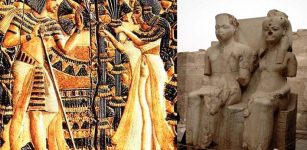 Ankhesenamun – Mysterious Death Of Tutankhamun’s Wife Ended The True Amarna Bloodline
Featured Stories | Mar 23, 2018
Ankhesenamun – Mysterious Death Of Tutankhamun’s Wife Ended The True Amarna Bloodline
Featured Stories | Mar 23, 2018 -
 Legend Of Milky Way’s Celestial Portal And The Star City From The Bowuzhi By Zhang Hua
Chinese Mythology | Feb 14, 2024
Legend Of Milky Way’s Celestial Portal And The Star City From The Bowuzhi By Zhang Hua
Chinese Mythology | Feb 14, 2024 -
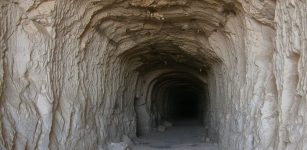 Ancient Superhighways: 12,000-Year-Old Massive Underground Tunnels From Scotland To Turkey
Featured Stories | Jul 19, 2015
Ancient Superhighways: 12,000-Year-Old Massive Underground Tunnels From Scotland To Turkey
Featured Stories | Jul 19, 2015 -
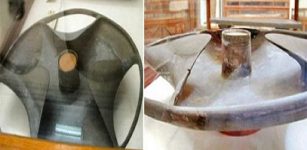 Schist Disk – Mysterious Piece Of Sophisticated Technology Could Rewrite History – Scientists Are Not Sure What They Are Dealing With
Artifacts | Jun 30, 2013
Schist Disk – Mysterious Piece Of Sophisticated Technology Could Rewrite History – Scientists Are Not Sure What They Are Dealing With
Artifacts | Jun 30, 2013 -
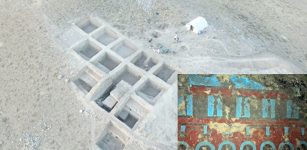 First Look At Mysterious 2,700-Year-Old Underground Frescoes Hidden Inside An Urartu Structure
Archaeology | Oct 6, 2022
First Look At Mysterious 2,700-Year-Old Underground Frescoes Hidden Inside An Urartu Structure
Archaeology | Oct 6, 2022 -
 Mysterious Ancient Falicon Pyramid And Its Complex Obscure History
Featured Stories | Nov 28, 2018
Mysterious Ancient Falicon Pyramid And Its Complex Obscure History
Featured Stories | Nov 28, 2018 -
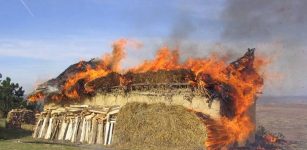 Mysterious Cucuteni-Tyrpillian Culture Burned Their Settlements For Unknown Reasons
Civilizations | Feb 12, 2021
Mysterious Cucuteni-Tyrpillian Culture Burned Their Settlements For Unknown Reasons
Civilizations | Feb 12, 2021 -
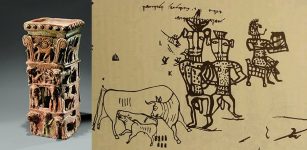 Ancient ‘Yahweh And His Asherah’ Inscriptions At Kuntillet ‘Ajrud Remain An Unsolved Biblical Mystery
Biblical Mysteries | Feb 12, 2021
Ancient ‘Yahweh And His Asherah’ Inscriptions At Kuntillet ‘Ajrud Remain An Unsolved Biblical Mystery
Biblical Mysteries | Feb 12, 2021 -
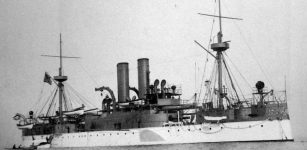 On This Day In History: Battleship USS Maine Explodes And Sinks – On Feb 15, 1898
News | Feb 15, 2017
On This Day In History: Battleship USS Maine Explodes And Sinks – On Feb 15, 1898
News | Feb 15, 2017 -
 Bees Originated From An Ancient Supercontinent Millions Of Years Earlier Than Previously Thought
Evolution | Jul 31, 2023
Bees Originated From An Ancient Supercontinent Millions Of Years Earlier Than Previously Thought
Evolution | Jul 31, 2023 -
 2,000-Year-Old Teeth Reveal The Diet Of An Iron Age Woman
Archaeology | Oct 26, 2022
2,000-Year-Old Teeth Reveal The Diet Of An Iron Age Woman
Archaeology | Oct 26, 2022 -
 Advanced Technology Of The Ancients: Artificial Platforms Of Mighty Nan Madol
Civilizations | Sep 14, 2018
Advanced Technology Of The Ancients: Artificial Platforms Of Mighty Nan Madol
Civilizations | Sep 14, 2018 -
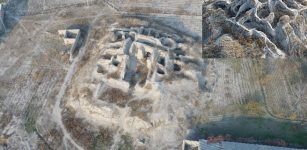 Sogdian Temple Of Jartepa II On Caravan Road Of The Silk Road
News | Sep 3, 2020
Sogdian Temple Of Jartepa II On Caravan Road Of The Silk Road
News | Sep 3, 2020 -
 How Large Was The ‘Giant’ Dunkleosteus Terrelli – Prehistoric King Of The Oceans?
News | Apr 10, 2023
How Large Was The ‘Giant’ Dunkleosteus Terrelli – Prehistoric King Of The Oceans?
News | Apr 10, 2023 -
 Kuthodaw Pagoda – ‘The World’s Largest Book’ Carved In 729 Marble Slabs
Featured Stories | Feb 24, 2018
Kuthodaw Pagoda – ‘The World’s Largest Book’ Carved In 729 Marble Slabs
Featured Stories | Feb 24, 2018 -
 Extraordinary Discovery Of First Viking Tower In Viborg, Denmark Re-Writes Viking History
Archaeology | Jan 30, 2017
Extraordinary Discovery Of First Viking Tower In Viborg, Denmark Re-Writes Viking History
Archaeology | Jan 30, 2017 -
 Sinuses Reveal More About The Evolution Of Ancient Humans
Archaeology | Oct 29, 2022
Sinuses Reveal More About The Evolution Of Ancient Humans
Archaeology | Oct 29, 2022 -
 How Did 20th-Century Philosophers Explain Ghosts And Other Spooky Subjects?
Featured Stories | Nov 8, 2024
How Did 20th-Century Philosophers Explain Ghosts And Other Spooky Subjects?
Featured Stories | Nov 8, 2024



